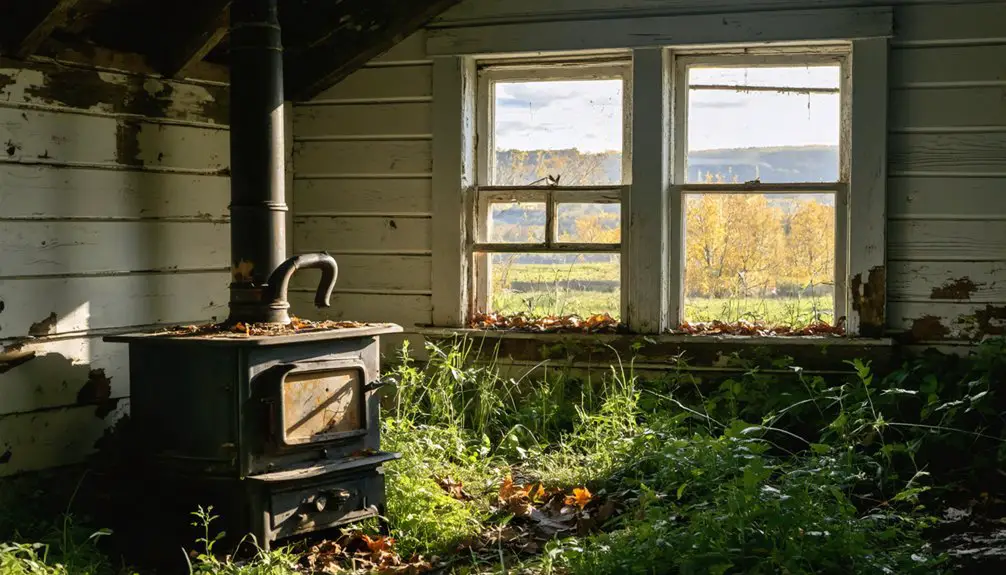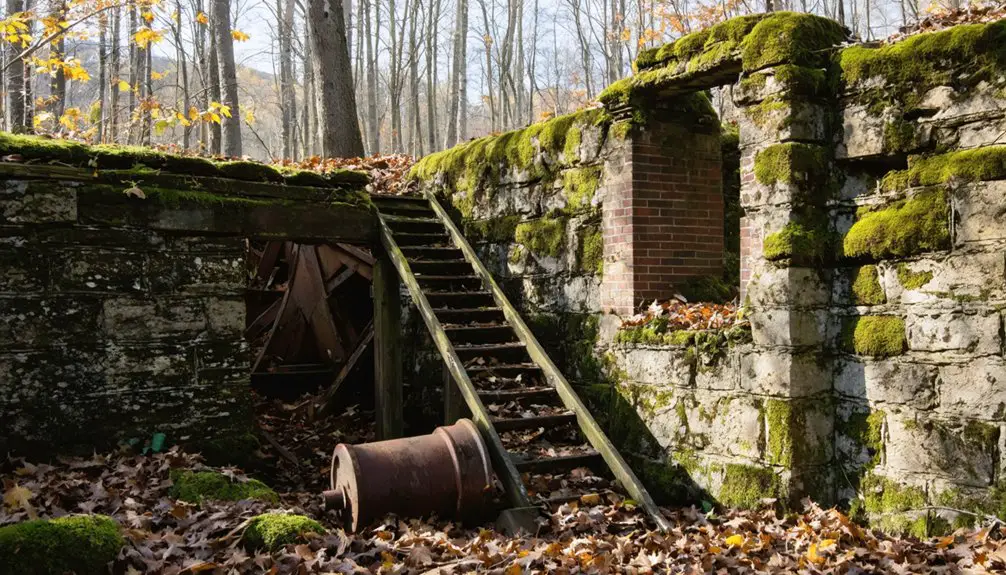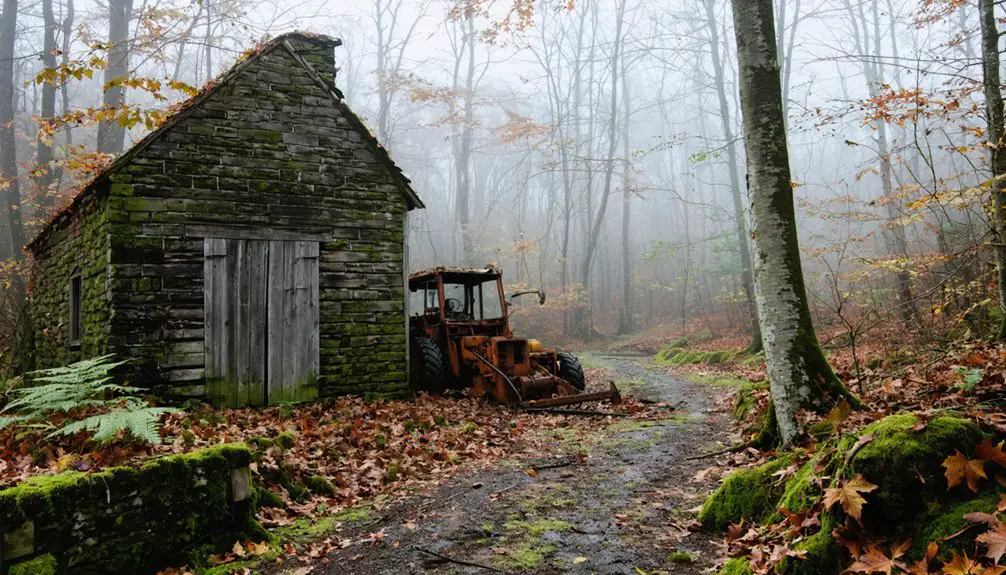You’ll find South Vershire’s haunting remains in Vermont’s former copper mining district, where operations boomed from 1821 to 1883. What began as a chance discovery of orange clay grew into America’s largest copper producer, employing 800 workers and supporting a thriving village of 1,000 residents. Today, ancient industrial ruins and mysterious folklore surround the abandoned mine site, where tales of supernatural occurrences and ghostly miners persist among the crumbling stone foundations and darkened tunnels.
Key Takeaways
- South Vershire became a ghost town after the collapse of its copper mining industry, which once employed over 800 workers.
- The abandoned Ely Mine and surrounding village ruins showcase Vermont’s industrial heritage through stone foundations and mining structures.
- The mining village reached nearly 1,000 inhabitants during peak production before economic decline and labor disputes led to abandonment.
- Supernatural folklore surrounds the ghost town, with reports of mysterious lights, ghostly apparitions, and unexplained phenomena near abandoned mines.
- Environmental damage from acid mine drainage and toxic sulfur emissions contributed to the area’s abandonment and current uninhabited state.
The First Settlers of Vershire
While Vermont was still a disputed territory following the French and Indian War, Vershire’s first inhabitant arrived in the form of squatter Irenus Knight. Like other parts of Vermont during this era, the area saw intense land grant disputes between various colonial powers. In 1779, Lenox Titus established the first permanent settlement, and his family marked several milestones in the town’s early history. His daughter Rosanna became the first white child born in Vershire on December 31, 1780, and his relative Martha Titus participated in the town’s first recorded marriage to Nathan West in 1787.
The formal establishment of Vershire came in 1781 when Captain Abner Seelye and 64 associates received a 21,961-acre land grant.
Soon after, more early families arrived, including the Paines, who settled on Paine Hill around 1791. These first settlers transformed the dense wilderness into farmland, building the foundations of their new community. The town was originally named Malden before being renamed to blend the names of Vermont and New Hampshire.
Discovery of the Mysterious Copper Mine
You’ll find the origins of South Vershire’s copper mine in 1821, when local farmers stumbled upon mysterious orange clay while digging near Beanville Road.
Your imagination might picture the eerie sight of sulfurous smoke and fireballs that would later fill the sky as the mining operations expanded into Vermont’s largest copper producer.
The site’s ancient industrial ruins still stand today, marking the spot where farmers first unearthed what would become one of America’s most significant 19th-century mining operations. The story gained local fame when a farmer’s daughter sank into a dirt mound, leading to the discovery of copper deposits in the area. The mine went on to produce an impressive 150 million pounds of copper from Orange County’s rich deposits over the next century.
Mysterious Orange Clay Discovery
In 1821, local farmers made a startling discovery while digging near Beanville Road in Vershire, Vermont – deposits of copper ore marked by distinctive orange and reddish-brown clay.
You can still see evidence of this unique geological formation today, as the orange clay continues to stain local streams and soil near the abandoned mine site.
The clay’s vibrant color comes from iron oxide and hydroxide precipitates, formed when sulfide minerals in the copper ore weather and oxidize.
This process creates acid mine drainage, which has left a lasting environmental impact.
The ore body lay just feet below the surface in what’s now known as the Orange County Copper District, where abandoned adits reveal the shallow nature of the mineralization.
These geological conditions made the site perfect for what would become America’s largest copper mine, where miners extracted ore containing an average of 3.3% copper.
Sulfurous Smoke and Fireballs
The 1821 discovery of copper ore near Beanville Road quickly led to more than just geological curiosity.
You’d have witnessed Vermont Mineral Factory Company’s smelting plant emerge near South Strafford by 1830, processing sulfide ores like chalcopyrite and pyrrhotite.
What you couldn’t miss was the suffocating sulfur emissions that devastated the landscape. The toxic smoke killed vegetation within a mile radius, and nearby farmers’ crops failed so often they sued the mine. Children as young as ten years old worked alongside adult miners in these hazardous conditions.
Underground, you’d face even deadlier hazards. Workers relied on buddy systems to navigate the dangerous environment where fireball phenomena occurred due to combustible sulfur compounds and poor ventilation.
The mine’s volatile conditions became so severe that during the 1880s labor strikes, you’d have seen the National Guard step in to maintain order.
Mining Site’s Ancient Origins
While local farmers initially stumbled upon the copper ore in 1821 near South Vershire, Vermont, they couldn’t have predicted its transformation into one of America’s most significant mining operations.
The ancient mining site, rich in geological formations including pyrrhotite and other sulfide minerals, quickly caught the attention of early industrialists.
The Farmers Company first worked the land from 1821 to 1853, developing rudimentary extraction methods.
When the Vermont Copper Mining Company took control in 1853, they expanded operations dramatically, especially as Civil War demand grew.
You’ll find evidence of this expansion in the remaining stone foundations and archaeological remnants that dot the landscape.
The site’s significance earned it recognition as a key 19th-century industrial archaeological treasure, eligible for historic preservation status.
Rise of Vermont Copper Mining Company
Founded in 1853-1854, Vermont Copper Mining Company emerged when New York investors purchased the existing Farmers Company mining property for $1,000. Under the leadership of Smith Ely, who later gained principal ownership, the company launched a new phase of copper extraction that would transform the region.
You’ll find that by the 1870s, the operation had grown into a thriving copper camp, employing over 800 workers, primarily Irish and Cornish immigrants. The economic impact was tremendous – the mine became America’s largest copper producer, reaching 3.5 million pounds of copper by 1880.
The bustling mining village of Ely (renamed from Vershire) expanded to include smelting facilities, roasting beds, churches, schools, and over 50 dwellings. With the arrival of the Connecticut and Passumpsic River Railroad, the operation became fully integrated into the regional economy. Worker unrest culminated in the Ely War of 1883 when miners demanded their unpaid wages.
Daily Life in the Mining Village

Life in South Vershire’s mining village sprang from humble beginnings into a vibrant community of nearly 1,000 inhabitants during its peak copper production years.
You’d find Irish and Cornish miners working long shifts underground, while their children split time between mine work and night school.
After grueling days in the copper mines, you could join your neighbors at community gatherings in one of two churches or catch performances at the village auditorium.
The town’s infrastructure supported your daily needs with a diverse mix of shops, from the hardware store to the local butcher.
Despite harsh working conditions, cultural traditions remained strong as immigrant families maintained their heritage.
You’d handle your finances at the local bank, get your hair cut at the barbershop, and find entertainment at community social events during precious evening hours.
Local Legends and Supernatural Tales
You’ll find South Vershire’s most enduring legends centered around the abandoned copper mines, where workers reported seeing ghostly figures and hearing unexplained machinery sounds long after operations ceased.
Local folklore surrounding “Brimstone Corner,” a particularly sulfurous section of the mine complex, tells of strange lights and eerie voices that supposedly lured unwitting travelers deeper into the tunnels.
Similar to the tales of dark stories in wild places, these mines became a focal point for the community to process their fears about the dangers lurking in the abandoned shafts.
The village itself became known for unexplained occurrences, including mysterious footprints in the snow that would abruptly end mid-trail and equipment that would inexplicably move between buildings overnight.
Like the nearby Glastonbury Mountain wilderness, the area has a long history of hikers and travelers vanishing without explanation, adding to its reputation for supernatural activity.
Mysterious Mine Site Phenomena
Despite the harsh scientific explanations behind the Ely Mine’s unsettling atmosphere, the ghost town’s haunting reputation stems from decades of mysterious phenomena reported by locals and visitors.
You’ll encounter an otherworldly landscape where acid drainage creates reddish-brown streams and barren soil, setting the stage for unexplained occurrences that defy rational explanation.
- Mysterious echoes of distant banging and mining activity resonate through abandoned tunnels
- Ghostly apparitions of former miners appear near the crumbling stone foundations
- Sudden temperature drops occur at specific locations throughout the ghost town
- Strange lights flicker in the darkness around the mine area at night
- Shadowy figures drift between structures, often linked to stories of lost miners
Brimstone Corner Folklore
The area’s Devilish folklore centers on the mid-18th century tale of Widow Krieger, who survived a witch dunking test, leading to the naming of Krieger Rocks.
Near the “Devils’ Alter,” a stone bearing mysterious red stains adds to the supernatural lore.
These Brimstone origins blend with broader Vermont traditions, connecting to other infernally-named locations like “Satan’s Kingdom.”
Similar to the region’s witch window traditions, local homesteads incorporated architectural features meant to ward off evil spirits.
Today, these stories continue shaping local identity, attracting those intrigued by Vermont’s peculiar cultural heritage and mysterious past.
Unexplained Village Occurrences
Supernatural occurrences in South Vershire have persisted long after the village’s abandonment, with locals and visitors reporting unexplained phenomena throughout the area.
You’ll encounter stories of ghostly encounters near old mine shafts, where disembodied voices and laughter echo through the ruins. The dense forest surrounding the former mining village harbors mysterious shadows and unexplained lights that drift through the darkness.
- Strange sounds, including phantom church bells and whispers, pierce the silence at night
- Shadowy figures in period mining clothes appear near abandoned mine entrances
- Unexplained equipment failures and compass disturbances occur near the ruins
- Ghostly children have been spotted around the village cemetery
- Cold spots and sudden wind gusts accompany ethereal moaning sounds, even in summer
The Decline of Copper Mining
Mining activities in South Vershire entered a steep decline after 1883, when plummeting copper prices combined with deteriorating ore quality to create unsustainable operating conditions.
You’d find economic mismanagement plaguing the operations, while mounting extraction costs of low-grade ore ate into profits. Labor disputes reached a boiling point during the “Ely War” when Irish and Cornish immigrant miners demanded overdue wages and safer conditions, leading to state militia intervention.
Technical challenges in the smelting process, coupled with the difficulty of separating copper from mixed ores, further strained operations.
As working conditions deteriorated, miners abandoned the area. Environmental damage from acid mine drainage and tailings sealed the town’s fate, leaving behind contaminated streams, stunted vegetation, and a legacy of industrial ruins that you can still see today.
What Remains Today

Today, scattered foundations and crumbling remnants are all that’s left of South Vershire’s once-bustling community.
You’ll find these traces hidden beneath a thick forest canopy, where nature has reclaimed the township. Wildlife habitats now flourish where houses and businesses once stood, creating an atmospheric backdrop for ruins exploration.
- Old dirt roads lead you through mountainous terrain to discover building foundations
- Cellar holes and mining infrastructure peek through dense vegetation
- Seasonal changes transform the site – winter snow blankets the ruins while summer foliage conceals them
- You might spot scattered artifacts like old tools and mining equipment
- Forest trails offer access, but you’ll need to be self-sufficient as there aren’t any visitor facilities
Historical Significance in Vermont
When Captain Abner Seelye and his 64 associates received a 21,961-acre land grant in 1781, they laid the foundation for South Vershire’s significant role in Vermont’s history.
As a Revolutionary War veteran, Seelye’s influence helped shape the town’s early development during Vermont’s essential shift to statehood in 1791.
South Vershire’s transformation into “Copperfield” marked its emergence as one of Vermont’s most important historical landmarks. The Ely copper mine, discovered in 1821, became a critical part of the region’s cultural heritage, especially during the Civil War when copper demand soared.
The discovery of Ely copper mine transformed South Vershire into Copperfield, becoming a vital part of Vermont’s Civil War economy.
You’ll find South Vershire’s story mirrors Vermont’s broader industrial evolution, from its military roots to its mining boom and eventual decline, representing a microcosm of the state’s economic and social development patterns.
Preserving South Vershire’s Legacy
Through coordinated preservation efforts, South Vershire’s historical legacy endures within the Town Center Building, where the Vershire Historical Society maintains an extensive collection of photographs, maps, and artifacts.
Despite preservation challenges, including limited grant eligibility for relocated structures, community collaboration with regional agencies helps protect the town’s historical essence through natural resource management and rural conservation goals.
- Access town archives by appointment to explore mining history and industrial heritage
- Visit archeological remains of the Ely Mine to witness Vermont’s industrial past
- Explore untouched natural landscapes that frame the ghost town’s original setting
- Discover worker housing ruins and sawmill sites that tell the story of early industry
- Connect with local historical societies to share in preservation and education efforts
Frequently Asked Questions
What Happened to the Original Mining Equipment and Tools From Ely Mine?
You won’t find any original mining equipment preserved today – it was mostly sabotaged during labor strikes, abandoned after closure in 1920, or dismantled for scrap, with no historical preservation efforts undertaken.
Were There Any Documented Deaths or Accidents During Mining Operations?
Mining mishaps marked historical accidents, with documented deaths from cave-ins and underground incidents. You’ll find records showing miners faced fatal risks, though specific death counts aren’t extensively detailed in safety records.
How Deep Were the Copper Mine Shafts at Their Maximum Depth?
You’ll find the maximum shaft depth reached 1,580 feet vertically, though mining techniques using 35-degree inclined shafts created longer passages stretching up to 3,386 feet along ore bodies.
What Was the Total Value of Copper Extracted During the Mine’s Operation?
You can’t determine the exact copper valuation since the mining economics data lacks historical price information, though thousands of tons were extracted across multiple processing stages from 1821-1920.
Did Any of the Original Mining Families’ Descendants Still Live in Vershire?
Like copper traces fading from mine walls, you won’t find direct family heritage links today. While local legends hint at mining descendants, there’s no verified evidence of original mining families remaining in Vershire.
References
- http://vermontdeadline.blogspot.com/2013/12/vershire-copper-mine-abandoned-vermont.html
- https://obscurevermont.com/tag/ely-mine/
- http://freepages.rootsweb.com/~gtusa/history/usa/vt.htm
- https://www.vermontpublic.org/local-news/2023-03-23/the-lucrative-largely-forgotten-history-of-copper-mining-in-vermont
- https://vershirevt.org/wp-content/uploads/2023/04/Vershire-Town-Center-history.pdf
- https://en.wikipedia.org/wiki/History_of_Vermont
- http://sites.rootsweb.com/~vermont/OrangeVershire.html
- https://familyhistory.lib.byu.edu/00000191-33c5-d3bf-a393-bff7494d0001/vermont-pdf
- https://semspub.epa.gov/work/01/460897.pdf
- https://vermonthistory.org/journal/70/vt703_404.pdf



